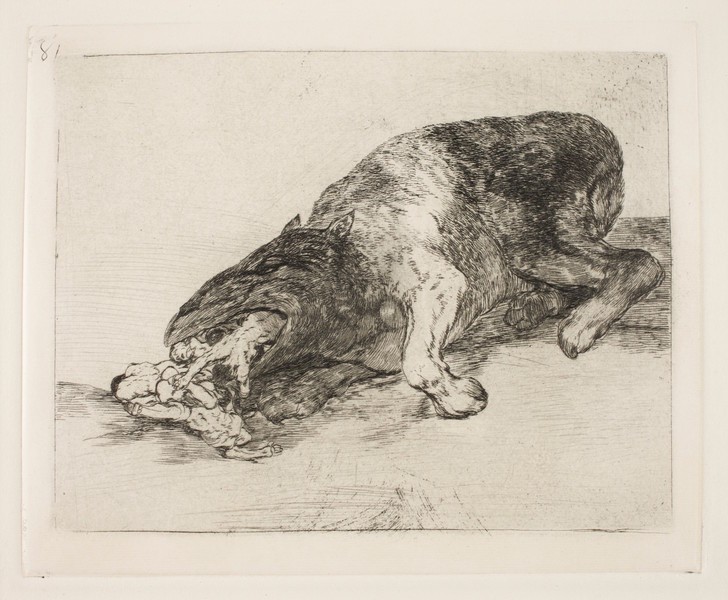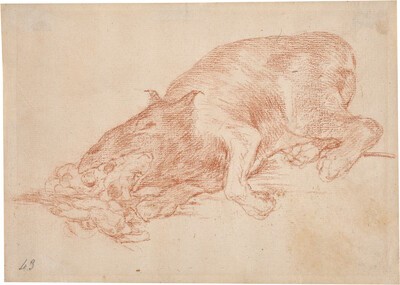- Cronología
- Ca. 1820 - 1823
- Dimensiones
- 175 x 216 mm
- Técnica y soporte
- Aguafuerte, punta seca y buril
- Reconocimiento de la autoría de Goya
- Undisputed work
- Ficha: realización/revisión
- 06 Jan 2011 / 01 Jun 2023
- Inventario
- 225
See Sad forebodings of what is to come.
The title of the print was handwritten by Goya on the first and only series known to us at the time of its production, which the painter gave to his friend Agustín Ceán Bermúdez. Thus the title was subsequently engraved on the plate without any modification from Ceán Bermúdez's copy for the first edition of the Disasters of War published by the Royal Academy of Fine Arts of San Fernando in Madrid in 1863.
A preparatory drawing of this engraving is in the Prado Museum
An animal that we cannot identify is positioned diagonally in this engraving, with its mouth facing the viewer. Naked human bodies, perhaps corpses, emerge from it.
This beast has strong analogies with the one in the engraving in No. 40, Some Party Pulls, in which a woman fiercely fights it and plunges a knife into its neck, and it could even be thought to be a continuation of that one. The carcass of the animal could be an allegory of the war that has brought death and desolation. From it emanate the fruits of it all, the naked and perhaps lifeless bodies of the victims of the conflict. This large, dull, almost putrefied anatomy, without hope or capacity for regeneration, contrasts sharply with the body of Truth on the verge of resurrection in engraving no. 80, If He Will Rise, full of light.
One of Goya's possible visual sources for this print may have been the engraving by Pieter Brueghel the Elder (Breda, 1525-Brussels, 1569) illustrating the proverb The Big Fish Eats the Small, although he may also have seen a print by Jacques Callot (Nancy, 1592-1635, Nancy) entitled The Temptation of Saint Anthony (1635), part of the wartime series Les Misères et les Malheurs de la Guerre. In it a strange beast resembling a dragon vomits all kinds of weapons.
In the overall context of the Disasters of War series, this engraving plays a conclusive role, perhaps an invitation to reflection. Through this image, which arouses revulsion in the viewer, the painter metaphorically captures the balance of the harsh conflict, which has brought nothing good.
The plate is in the National Chalcography (cat. 332).
-
De grafiek van GoyaRijksmuseum RijksprentenkabinetAmsterdam1970from November 13th 1970 to January 17th 1971cat. 91
-
Goya. Das Zeitalter der Revolucionen. Kunst um 1800 (1980 – 1981)Hamburger KunsthalleHamburg1980cat. 96
-
Francisco Goya. Sein leben im spiegel der graphik. Fuendetodos 1746-1828 Bordeaux. 1746-1996Galerie KornfeldBern1996from November 21st 1996 to January 1997cat. 171
-
Goya: Prophet der ModerneAlte NationalgalerieBerlin2005from July 13th to October 3th 2005. Exhibitied also at the Kunsthistorischemuseum, Vienna, October 18th 2005 to January 8th 2006, consultant editor Manuela B. Mena Marquéscat. 126
-
Goya, grabadorMadridBlass S.A.1918cat. 183
-
Goya engravings and lithographs, vol. I y II.OxfordBruno Cassirer1964cat. 201
-
Vie et ouvre de Francisco de GoyaParísOffice du livre1970cat. 1136
-
Dibujos de Goya: Los álbumesBarcelonaNoguer1973
-
A solution to the enigma of Goya’s emphatic caprices nº 65-80 of The Disasters of WarApollo1978pp.186-191
-
Goya. Arte e condizione umanaNaplesLiguori editore1990lam. 207
-
Catálogo de las estampas de Goya en la Biblioteca NacionalMadridMinisterio de Educación y Cultura, Biblioteca Nacional1996cat. 307
-
Goya. In the Norton Simon MuseumPasadenaNorton Simon Museum2016pp. 114-151

